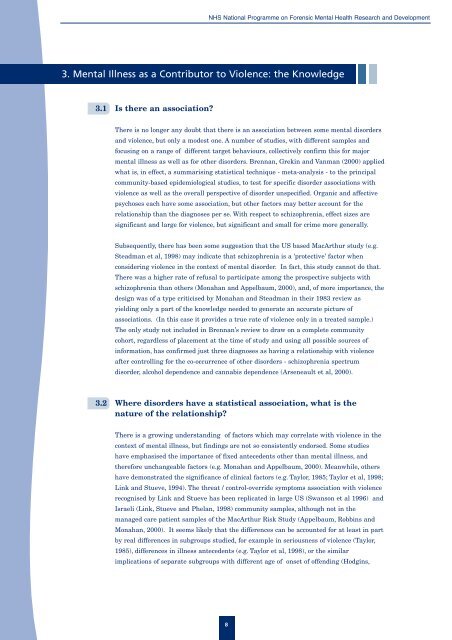Mental Illness and Serious Harm to Others - University of Liverpool
Mental Illness and Serious Harm to Others - University of Liverpool
Mental Illness and Serious Harm to Others - University of Liverpool
Create successful ePaper yourself
Turn your PDF publications into a flip-book with our unique Google optimized e-Paper software.
NHS National Programme on Forensic <strong>Mental</strong> Health Research <strong>and</strong> Development<br />
3. <strong>Mental</strong> <strong>Illness</strong> as a Contribu<strong>to</strong>r <strong>to</strong> Violence: the Knowledge<br />
3.1 Is there an association?<br />
There is no longer any doubt that there is an association between some mental disorders<br />
<strong>and</strong> violence, but only a modest one. A number <strong>of</strong> studies, with different samples <strong>and</strong><br />
focusing on a range <strong>of</strong> different target behaviours, collectively confirm this for major<br />
mental illness as well as for other disorders. Brennan, Grekin <strong>and</strong> Vanman (2000) applied<br />
what is, in effect, a summarising statistical technique - meta-analysis - <strong>to</strong> the principal<br />
community-based epidemiological studies, <strong>to</strong> test for specific disorder associations with<br />
violence as well as the overall perspective <strong>of</strong> disorder unspecified. Organic <strong>and</strong> affective<br />
psychoses each have some association, but other fac<strong>to</strong>rs may better account for the<br />
relationship than the diagnoses per se. With respect <strong>to</strong> schizophrenia, effect sizes are<br />
significant <strong>and</strong> large for violence, but significant <strong>and</strong> small for crime more generally.<br />
Subsequently, there has been some suggestion that the US based MacArthur study (e.g.<br />
Steadman et al, 1998) may indicate that schizophrenia is a 'protective’ fac<strong>to</strong>r when<br />
considering violence in the context <strong>of</strong> mental disorder. In fact, this study cannot do that.<br />
There was a higher rate <strong>of</strong> refusal <strong>to</strong> participate among the prospective subjects with<br />
schizophrenia than others (Monahan <strong>and</strong> Appelbaum, 2000), <strong>and</strong>, <strong>of</strong> more importance, the<br />
design was <strong>of</strong> a type criticised by Monahan <strong>and</strong> Steadman in their 1983 review as<br />
yielding only a part <strong>of</strong> the knowledge needed <strong>to</strong> generate an accurate picture <strong>of</strong><br />
associations. (In this case it provides a true rate <strong>of</strong> violence only in a treated sample.)<br />
The only study not included in Brennan’s review <strong>to</strong> draw on a complete community<br />
cohort, regardless <strong>of</strong> placement at the time <strong>of</strong> study <strong>and</strong> using all possible sources <strong>of</strong><br />
information, has confirmed just three diagnoses as having a relationship with violence<br />
after controlling for the co-occurrence <strong>of</strong> other disorders - schizophrenia spectrum<br />
disorder, alcohol dependence <strong>and</strong> cannabis dependence (Arseneault et al, 2000).<br />
3.2 Where disorders have a statistical association, what is the<br />
nature <strong>of</strong> the relationship?<br />
There is a growing underst<strong>and</strong>ing <strong>of</strong> fac<strong>to</strong>rs which may correlate with violence in the<br />
context <strong>of</strong> mental illness, but findings are not so consistently endorsed. Some studies<br />
have emphasised the importance <strong>of</strong> fixed antecedents other than mental illness, <strong>and</strong><br />
therefore unchangeable fac<strong>to</strong>rs (e.g. Monahan <strong>and</strong> Appelbaum, 2000). Meanwhile, others<br />
have demonstrated the significance <strong>of</strong> clinical fac<strong>to</strong>rs (e.g. Taylor, 1985; Taylor et al, 1998;<br />
Link <strong>and</strong> Stueve, 1994). The threat / control-override symp<strong>to</strong>ms association with violence<br />
recognised by Link <strong>and</strong> Stueve has been replicated in large US (Swanson et al 1996) <strong>and</strong><br />
Israeli (Link, Stueve <strong>and</strong> Phelan, 1998) community samples, although not in the<br />
managed care patient samples <strong>of</strong> the MacArthur Risk Study (Appelbaum, Robbins <strong>and</strong><br />
Monahan, 2000). It seems likely that the differences can be accounted for at least in part<br />
by real differences in subgroups studied, for example in seriousness <strong>of</strong> violence (Taylor,<br />
1985), differences in illness antecedents (e.g. Taylor et al, 1998), or the similar<br />
implications <strong>of</strong> separate subgroups with different age <strong>of</strong> onset <strong>of</strong> <strong>of</strong>fending (Hodgins,<br />
8
















